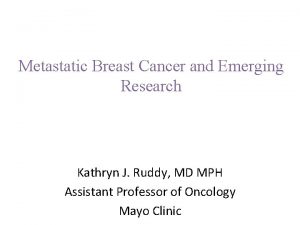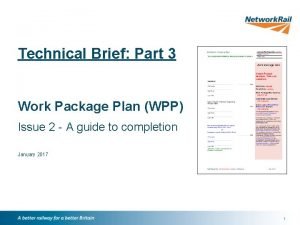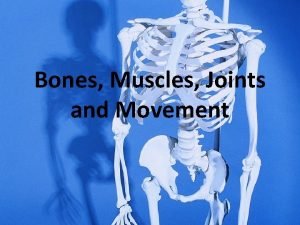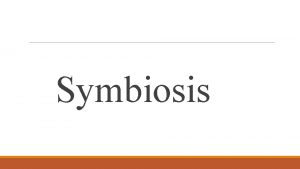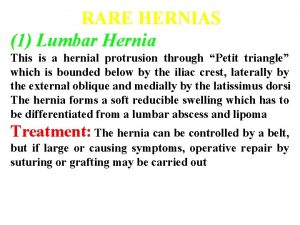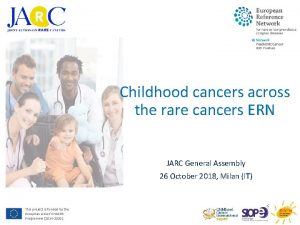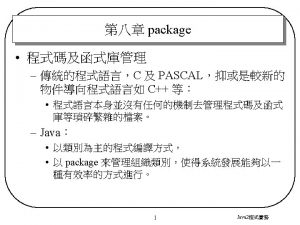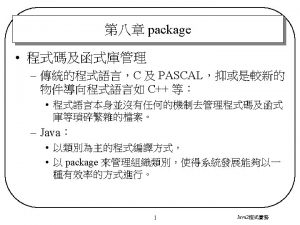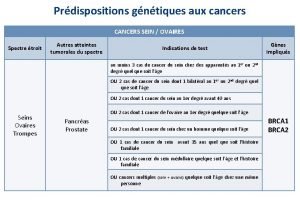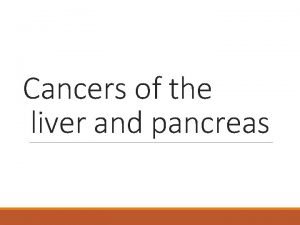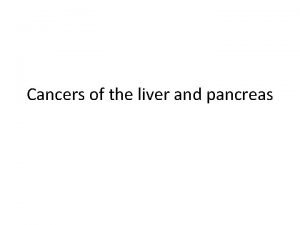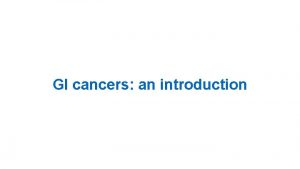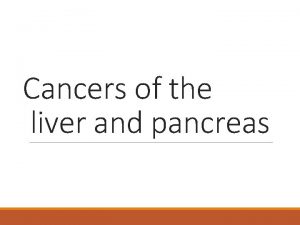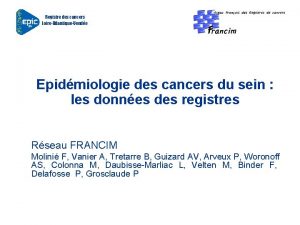Joint Action on Rare Cancers JARC Work Package





























- Slides: 29

Joint Action on Rare Cancers (JARC) – Work Package 5 Assuring Quality of Care General Assembly Milan, 25 October 2018 Messages and Issues emerging

WP 5 Tasks 1. Survey the coverage of existing Rare Cancer networks in Member States 2. Design systems-based standards for Rare Cancer Networks: a) For the 3 Cancer ERNs b) Potentially for Member States 3. Design QA processes – accreditation/audit/improvement plans, in conjunction the ERN monitoring group

Mapping the existing Networks of rare cancer care WP 5. 1 Project team: Harriët Blaauwgeers, Annemiek Kwast, Jan Maarten van der Zwan, Simon Oberst, Annalisa Trama

Methods Aim: Map the existing networks of care for all 11 families of rare adult cancers, across all Member States and identifying gaps in current scenarios. Phase 1: questionnaire (completed) Phase 2: confirmation given answers and interviews (ongoing) Positive response rate 82% (n=23). JARC members reponse rate 94% (n=17).

Brief results: General cancer care networks 16 (70%) MS have general cancer care networks at a national and/or regional level 7 (30%) MS no cancer care networks

Rare cancer care networks • 2 MS rare cancer network in general • 14 (61%) MS tumour spec networks Varies from 1 – 11 families of RC • 9 MS no rare cancer care networks

Tumour specific rare cancer networks Haematological Central Nervous. . . Skin and eye. . . Thorax Head and neck Endocrine organs Digestive tract Neuroendocrine Male genital organs Female genital orga. . . Sarcoma 0 2 4 National 6 8 Regional 10 Both 12

Recommendations • It is recommended that in every Member State networks of care for rare cancers are established. The organisation of these networks can differ among the Member States. • The rare cancer networks should ensure that patients have access to the expertise available throughout their Member State (and ensure the integration of the ERN within the MS). • Special attention should be shown to the tumour types which are less organised in networks according to this mapping (e. g. Rare Thorax tumours and Male Genital tumours). • To evaluate these networks it is important to develop a set of standards taking into account the existing differences between Member States.

WP 5 Quality Assurance

WP 5 Quality Assurance What have we achieved? Quality Standards • We have achieved a 6 th draft of the Quality Standards for Rare Cancer Networks, which have received input from: • Associated Partners in the JARC, EURACAN, Eurordis, ECPC and others • We have designed standards which can apply in every Member State • The Standards are intended to be aspirational as to high quality and be consistent with ERN requirements

We performed a literature review on existing care networks worldwide, and also an in-depth comparative study of other Cancer accreditation standards We studied analysed the following Quality Standards in depth before drafting our proposals for Rare Cancer Networks: • OECI Quality Standards • German Cancer Society (Deutsche Krebsgesellschaft) • INCa (National Cancer Standards in France) • ERN application criteria • ENETS quality standards for the network of Neuro-Endocrine Tumours

1 – ORGANISATION OF THE NETWORK GOVERNANCE • Planning and Strategy • Boards; periodic review, cooperation agreements; implementation of evidence based change • Governance on clinical guidelines • Policy making (network level) and research agenda (common topics) • Resource allocation • Sustainability: Funding and Education PATIENTCENTREDNESS • Principles and Capacities around: • Care Provision – continuity of care • Social and Financial needs • Patient information, education and support INFRASTRUCTURE • Teleconferences or online system (such as the ERN CPMS) • Data acquisition and monitoring • Shared certified DBs and registries • Inventory of the network’s diagnostic and treatment infrastructure and distribution QUALITY CONTROL • Monitoring • Internal auditing systems, QA systems in place • Benchmarking between networks and within the network, performance and outcomes measurement and monitoring • PDCA cycle ACCOUNTABILITY • Transparency • Dissemination of results and reports • Involvement of key-stakeholders (especially patient representatives) in the evaluation and planning, relationships with stakeholders ( big pharma, health authorities) * Tier 1: data useful for decision making at network level: e. g. volumes, dashboards of indicators, . . . ; clinical data management should be tackled in tier 2

2 – NETWORKING IN ALL RARE CANCERS (Clinical implementation) Management • Tumour boards and standard of care implementation • Referral systems among the HCPs • Shared research project management • Induction of new members • Cross border finances Decision-making • Composition of members of the MDTs • Competences assessment and monitoring • Documentation and communication for care delivery Care Delivery Research Education • Standardise care/equal access for diagnosis and treatment • Compliance with (common) guidelines • Provision of competent care team • Assurance of minimum requirements for facilities and treatments • Clinical Trials shared among the network partners • High quality (practice changing) publications • Patient education programmes • Training and Education: Health care professionals at all levels

Immediate aim on Quality Standards will need to be approved at a Plenary Consensus Meeting in March 2019 Work required before then: • Work with the European working group of leaders of the ERNs for their indicators to monitor ERNs • Reorder the standards to conform to ERN eligibility criteria chapters • Agree with the ERN monitoring group a Core set of 25 -30 standards for initial implementation • Agree with Cancer ERNs what quality indicators are for collection every year (say 20 indicators in addition to the 18 Structure, Process and Outcome indicators for all ERNs)

Messages emerging for the Endpoint of the JARC • We need to concentrate on Nations without Rare Cancer Networks and do policy work with MS to create them • The EU only has capacity for a core set of 25 -30 standards and maybe 20 numeric indicators (Other ERNs have none as yet) • We need to suggest an evaluation system which does not overburden ERNs and National Networks with a large number of indicators and Peer Reviews. • Nevertheless the full set of standards should be available as “good practice” for MS to apply (and some will, or will adapt) • • Do we need a more robust Patient Charter for Rare Cancers? Emphasis should be placed on the standards of the ‘spokes’ in National Networks where most patients are initially seen; is there equality of treatment and care?

Intended use of the Standards for Rare Cancer Networks (Endpoint) • • We want to work with the ERN monitoring group so that the Core Standards will be adopted by the EC for the cancer ERNs* They would be ‘advisory’ or ‘good practice’ for National/Regional Rare Cancer Networks The standards proposed are general enough to adapt to many different situations, and make them suitable to many different countries. *NB the European Commission has only so far set eligibility criteria and application standards for becoming an ERN. It is working on an accreditation or quality framework for improving or monitoring standards.

We have applied some other overarching principles for Rare Cancer Networks • • • Expertise travels rather than the patient Referral and diagnostic pathways should be clearly defined, assuring continuity and quality of care, information and support for patients and families. Patient involvement at all levels Key involvement in clinical trials, sample collections and bioinformatics There should be great communications systems throughout the network – common platforms, or connectivity; videoconferencing

Standards Governance Sub standards The Network convenes a General Assembly of The General Assembly comprises all the Members of the Network. all its Members at least once annually. There are clear rules and eligibility criteria for becoming a Member of the Network Comments The precise form of Governance employed will depend on the nature and scope of the network The criteria to become a Member of the network are clearly defined; new Members are able to be admitted regularly to the Network The General Assembly approves resource allocations and the Annual Nomenclature may differ between Budget The General Assembly receives an Annual Report from the Research networks, but a Board or Committee of leading researchers in the relevant families Board/Committee of rare cancers is deemed essential. There is one Member within the Network One individual is appointed by the Coordinating Member to act as This is relevant to ERNs but other networks designated as the Coordinating Member. "Coordinator" of the Network and normally also the Chair of the may have different governance structures Executive Board The network has an Executive Board of The Executive Board is composed of individuals elected or confirmed Some networks may have different Directors (or equivalent) elected from among from the full Membership of the network nomenclature for "Executive Board". its members which provides ultimate Essentially this means those with delegated Governance of the strategy, policy and authority from the full membership of the activities of the Network. The Executive Board includes one or more e. PAGs' representatives (European Patients Advocate Groups) The Executive Board meets regularly face to face or by Regularly rather than 3 times F 2 F teleconference The role and terms of reference of the Executive Board are clearly defined and documented in a set of governance policies, rules and procedures. The Executive Board monitors the activity, outcomes and initiatives of the Network and its members in regard to their specific, predefined roles The Network has a Strategic Plan covering a 3 -The strategic plan includes: 1) Assurance of the sustainability of the Improvement of patients' care pathways 5 year period. network (e. g. financing, education) 2) Research agenda (common inserted topics). 3) Risk management. 4) Improvement of patients' care pathways. 5) Policy making. 6) Integration of new members The Executive Board ratifies (or otherwise delegates to expert groups This may depend upon the structure of the delegates to expert groups in the network) all clinical guidelines to be used for network patients, Network clinical guidelines to be used for Network this includes but is not limited to guidelines used by the network for patients. diagnosis, treatment, follow up, clinical research, and ethical conduct

Patient Centredness Standards Sub standards Comments Patients' needs, expectations and satisfactions are collected annually; the information is used by the network to take strategic decisions Patients and patients' representatives are actively The Executive Board has established mechanisms to incorporate e. PAGs added involved in planning and monitoring of the strategic the voice and opinions of patients and families through activities of the network (E. g. involvement in the nominated e. PAGs' representatives (these e. PAGs represent the definition of policies, strategies and improvement plans, whole patient community of the ERN as well as specific disease review pathways, improve referral procedures, groups encompassed in the ERNs). communication) The Network has processes that ensure that at all times in Old draft: At the point the patient the pathway of a Network Patient it is clear which becomes a Network patient they are physician and which HCP has the responsibility for the allocated a named case manager (who may care of the patient or may not be a physician) The Network has processes for ensuring continuity of care There are protocols/procedures for handover of responsibility Precise processes will depend on the from the initial contact, following the patient through all to a different HCP Member/Physician at different stages in the nature of the network (Co. R Network, or phases of care patient pathway. Hub and Spoke) The Network has policies and procedures for ensuring the Policies and Procedures for holistic care include psychological Precise processes will depend on the holistic care of patients and their care providers from the support for patients and their care givers, financial and nature of the network (Co. R Network, or beginning of the diagnostic process throughout the whole employment advice, rehabilitation support, End of Life care and Hub and Spoke) survivorship span, including rehabilitation or End of Life Bereavement Support for families The Network has specific policies and procedures for Policies and procedures for the holistic care of children who are Ask SIOPE to define survivorship passport ensuring the holistic care of patients with childhood referred to the Network include use of the "Survivorship cancers and their families throughout the whole patient Passport". pathway, including survivorship, long-term effects, and transition to adult care The Network ensures that each HCP in the network has The Network ensures that each HCP provides transparent Emphasis on the HCP not the network. Is policies, protocols and processes to protect patients from information on the patient safety programmes of its patients. the standard specific enough? preventable harm Information material about the Network and each The Information about the members of the Network and all Member is available in all relevant languages relevant clinical pathways is sufficient to enable patient access to the Network in in languages commonly spoken by the population served The Network has a policy/guideline on providing general Members of the Network have readily available information for The main standard will depend on the and disease specific patient education resources either at patients on general themes in cancer and in specific rare nature of the network. An ERN composed network or HCP level. cancers of Co. Rs would not be expected to hold a A common database of educational material is available The Network produces/provides information material that is full database of information for all its within the Network and accessible to the patients readable, up-to-date, appropriate and available in languages members, whereas a Hub and Spoke commonly spoken by the population served network would be expected.

Infrastructure Standards Sub standards The Network has a Co-ordinating Team The Infrastructure Co-ordinating Team or or Board for infrastructure. Board includes clinical membership and technical membership covering at least ICT Comments Networks will have different nomenclature for this Board, but the concept is of a standing body with authority delegated by the Board to specify, decide and where possible fund the infrastructure development of the network such as IT platforms The Infrastructure Co-ordinating Team or Board has a clearly defined role in establishing and maintaining a functional Network infrastructure The Network uses a shared system for The Network maintains communication information and data exchange. facilities that allow real-time confidential submission and review of clinical information, including histopathology, radiology, and medical photography by all network members e. g. CPMS (Clinical Patient Management System). The Network has a consistent template of an Electronic Patient Record or MDT decision platform which conforms to Data Protection Law and is accessible to the team caring for each specific patient Care will re required re Data Protection law The Network has an effective website The Network website enables access to which provides relevant information to clinicians and patients to be referred to the patients and clinicians Network, and all relevant information about the Network Members The Network registers summary data Care re Data Protection law. Note the distinction between related to diagnoses and outcomes on the "summary" data here, and the protected data at line 31 a shared database. for the extended MDT standards Sub standards Comments The Network has a Co-ordinating Team or Board for The Infrastructure Co-ordinating Team or Board includes Networks will have different nomenclature for this Board, but the concept is of a infrastructure. clinical membership and technical membership covering at standing body with authority delegated by the Board to specify, decide and least ICT where possible fund the infrastructure development of the network such as IT platforms The Infrastructure Co-ordinating Team or Board has a clearly defined role in establishing and maintaining a functional Network infrastructure The Network uses a shared system for information The Network maintains communication facilities that allow and data exchange. real-time confidential submission and review of clinical information, including histopathology, radiology, and medical photography by all network members e. g. CPMS (Clinical Patient Management System). The Network has a consistent template of an Electronic Patient Record or MDT decision platform which conforms to Data Protection Law and is accessible to the team caring for each specific patient Care will re required re Data Protection law The Network has an effective website which provides relevant information to patients and clinicians The Network website enables access to clinicians and patients to be referred to the Network, and all relevant information about the Network Members The Network registers summary data related to diagnoses and outcomes on a shared database. Care re Data Protection law. Note the distinction between the "summary" data here, and the protected data at line 31 for the extended MDT

Quality Control Standards Sub standards Comments The Network ensures that each HCP The Network maintains a quality and risk Both the network and each HCP will require a quality system Member has an integrated quality and dashboard of its activities, with at least a semi and a dashboard, but it is not expected in cases of ERN-type risk management and safety -annual evaluation of its content Co. R networks that all the quality systems will be exactly the requirements system same. But key quality data need to be collected by the network. The Network has a co-ordinating team The Executive Board ensures that each HCP or Board for Quality initiates service improvements after analysing the results of dashboard of quality and risk and safety factors. Each Tumour Board communicates trends in the diagnostic, treatment, (outcome) data to the Board in order to improve care and This will rely on effective data on quality indicators being strategic planning collected by the Network from its Members Systems for recording and analysing adverse event (including SAE, SUSAR) are in use by all Members of the Network and is shared with the Network as a whole A report on adverse events in the Network is analysed by the Executive Board at least annually The Network produces an annual Quality Report and Improvement Plan standards Sub standards The Network ensures that each HCP Member has an The Network maintains a quality and risk dashboard of its integrated quality and risk management and safety activities, with at least a semi-annual evaluation of its requirements system content Comments Both the network and each HCP will require a quality system and a dashboard, but it is not expected in cases of ERN-type Co. R networks that all the quality systems will be exactly the same. But key quality data need to be collected by the network. The Network has a co-ordinating team or Board for The Executive Board ensures that each HCP initiates service Quality improvements after analysing the results of dashboard of quality and risk and safety factors. Each Tumour Board communicates trends in the diagnostic, treatment, (outcome) data to the Board in order to improve This will rely on effective data on quality indicators being collected by the care and strategic planning Network from its Members Systems for recording and analysing adverse event (including SAE, SUSAR) are in use by all Members of the Network and is shared with the Network as a whole A report on adverse events in the Network is analysed by the Executive Board at least annually The Network produces an annual Quality Report and Improvement Plan The Network ensures that each Network Member has an internal audit system which can be called upon to provde data to the Network The Network exchanges and disseminates knowledge, including incidence, within the Network and with other networks The Network ensures that each Network Member has an internal audit system which can be called upon to provide data to the Network The Network exchanges and disseminates knowledge, including incidence, within the Network and with other networks

Accountability Standards Sub standards The Network has a policy of transparency to The Network provides an annual report that is its Members, Patients and the Public accessible and understandable for citizens including the following topics: The results of the quality and risk dashboard of the network; Network goals and achievements; results of patient surveys; Summarised patient outcomes; Research developments. The Executive Board has a communication plan and has communication tools. to 1) support collaborations with other organisations 2) promote the patient access to the Network. The latter is done is close collaboration with e. PAGs of the Network.

Management Standards Sub standards Comments The Network ensures that a Tumour Board Application of this standard will depend on the nature for each family of rare cancers covered by of the network. An ERN-type network of Co. Rs will not The role and responsibilities of each Tumour the Network is established either at HCP level necessarily have standing network Tumour Boards; Board are clearly defined and documented. or at Network level (if not available at every however this should be the case for a more local Hub HCP) and Spoke type network. Minimum representation of disciplines in each Tumour Board is defined by the Every network should ensure this of its HCP members. Network to ensure optimal patient management The responsibilities of the different disciplines involved in each Tumour Board are defined and described. The Network has processes that ensure that at all times in the pathway of a Network There is a clear process in the Network to define the point at which a patient becomes Patient it is clear which physician and which a Network patient HCP has the responsibility for the care of the Duplication to be sorted out here with Patientpatient centeredness The rules of patient management decision. This standards would normally only apply to a Hub and making for Network Patients are defined and Spoke-type network approved by the Executive Board The number of Network Patients discussed in The network has systems to record the each Tumour Board and summarised The emphasis here is on Network Patients, not every number of Network Patient discussions in outcomes are reported annually to the patient of constituent HCPs Tumour Boards and the outcomes of patients Executive Board of the Network Standards Sub standards Comments The Network ensures that a Tumour Board for each family Application of this standard will depend on the nature of the network. An of rare cancers covered by the Network is established either The role and responsibilities of each Tumour Board are ERN-type network of Co. Rs will not necessarily have standing network at HCP level or at Network level (if not available at every clearly defined and documented. Tumour Boards; however this should be the case for a more local Hub and HCP) Spoke type network. Minimum representation of disciplines in each Tumour Board is defined by the Network to ensure optimal patient Every network should ensure this of its HCP members. management The responsibilities of the different disciplines involved in each Tumour Board are defined and described. The Network has processes that ensure that at all times in There is a clear process in the Network to define the point the pathway of a Network Patient it is clear which physician at which a patient becomes a Network patient and which HCP has the responsibility for the care of the patient Duplication to be sorted out here with Patient-centredness The rules of patient management decision-making for This standards would normally only apply to a Hub and Spoke-type Network Patients are defined and approved by the network Executive Board The number of Network Patients discussed in each Tumour The network has systems to record the number of Network The emphasis here is on Network Patients, not every patient of Board and summarised outcomes are reported annually to Patient discussions in Tumour Boards and the outcomes of constituent HCPs the Executive Board of the Network patients

Decision Making Comments Standards Sub standards Tumour Board meetings follow defined criteria The Network has adequate processes to ensure that all Application of the standards in this section will about documentation and communication for care relevant data are available to members of the Tumour Board depend on the nature of the network. An ERNdelivery in a timely manner type network of Co. Rs will not necessarily have standing network Tumour Boards; however There is adequate notice of patient inclusion in Tumour Board this should be the case for a more local Hub and Spoke type network. discussions The Network HCP Members actively involve patients in shared decision-making The Network ensures implementation of agreed guidelines and/or protocols The conclusions and advice resulting from the Tumour Board meeting are documented in the medical record of the patient The inclusion of patients in clinical trials is a structural formal aspect of each Tumour Board meeting According to a defined procedure, the conclusions and recommendations resulting from the Tumour Board are communicated to the patient "shared decision-making" may require a definition According to a defined procedure the implementation of the Tumour Board decision recorded in the patient's file is designated to a named responsible person Patient care decisions in the Tumour Board comply with agreed guidelines unless a deviation is deliberately chosen. Deviations from agreed guidelines, and treatment decisions where no guidelines are available for very rare cancers, are clearly documented and re-evaluated The network ensures that each Tumour Board reviews best practice evidence and uses this evidence to update guidelines and protocols Reviews of best practice evidence, and updating of guidelines and protocols are made in conjunction with e. PAGs/Patient representatives The Network ensures that there is an internal audit [5% of] Tumour Board decisions [on a selected basis] are of selected Tumour Board processes annually reviewed once a year either at HCP level or at Network level

Care Delivery Standards Sub standards The Network has established clear patient The Network ensures regular evaluation of pathways based on the needs of patients, patient pathways [at least once every 3 clinical evidence, and best use of resources. years] Comments Application of the standards in this section will depend on the nature of the network. An ERN-type network of Co. Rs will not necessarily have established clear patient pathways; however this should be the case for a more local Hub and Spoke type network. The Network promotes the safe use of highly specialized diagnostic techniques and services. The Network promotes among the Network Members the application of recognized international certifications, and accreditation schemes (for instance JACIE for Bone Marrow Transplant, and ISO 9001/15189 accreditations) The Network has systems to record the The Network and each Network Member records and reports annually to the Executive waiting time of each Network Patient from Board the average waiting time of Network first referral into the Network and date of Patients from first referral to the Network diagnosis Make this wording consistent with ERN requirements and date of Diagnosis Nov 2017 The Network has systems to record the The Network and each Network Member records and reports to the Executive Board waiting time of each Network Patient from the average waiting time of Network Patients diagnosis to first treatment from diagnosis to first treatment The Network-agreed minimum volume The Executive Board ensures that the requirements for key procedures are met network Member performing key patient This draft standard needs some clinical reference points procedures conforms to the Network-agreed to ensure applicability - consult EURACAN and minimum volumes Eurobloodnet Standards Sub standards The Network has established clear patient pathways based The Network ensures regular evaluation of patient on the needs of patients, clinical evidence, and best use of pathways [at least once every 3 years] resources. Comments Application of the standards in this section will depend on the nature of the network. An ERN-type network of Co. Rs will not necessarily have established clear patient pathways; however this should be the case for a more local Hub and Spoke type network. The Network promotes the safe use of highly specialized diagnostic techniques and services. The Network promotes among the Network Members the application of recognized international certifications, and accreditation schemes (for instance JACIE for Bone Marrow Transplant, and ISO 9001/15189 accreditations) The Network and each Network Member records and The Network has systems to record the waiting time of each reports annually to the Executive Board the average waiting Network Patient from first referral into the Network and time of Network Patients from first referral to the Network date of diagnosis and date of Diagnosis Make this wording consistent with ERN requirements Nov 2017 The Network has systems to record the waiting time of each The Network and each Network Member records and reports to the Executive Board the average waiting time of Network Patient from diagnosis to first treatment Network Patients from diagnosis to first treatment The Network-agreed minimum volume requirements for The Executive Board ensures that the network Member key procedures are met performing key patient procedures conforms to the This draft standard needs some clinical reference points to ensure Network-agreed minimum volumes applicability - consult EURACAN and Eurobloodnet

Research Standards Sub standards Comments The Network promotes research into rare The Network promotes basic, pre-clinical, and cancers at all levels and initiates and promotes clinical research into the causes, detection, and participation in clinical trials. treatment of rare cancers The Network has established a Research Board The Research Board/Committee reports annually to Nomenclature may differ between networks, but a to promote translational research into rare the Executive Board and to the General Assembly Board or Committee of leading researchers in the cancers on its activities relevant families of rare cancers is deemed essential. Practice-changing publications are regularly Publications by the Network are regularly achieved published by the Network in high impact journals The Network promotes tertiary prevention and rehabilitation studies The Network promotes economic and social studies/surveys, such as on the burden of rare cancers on the patient's life The results of Network research are made available in accessible language for patients and the public The Research Board identifies research gaps in rare cancers both in translational research and in clinical trials The Network makes publicly available Information on all phases of Clinical Trials is comprehensive and accessible information available to patients and Network clinicians about, and recruitment to, Clinical Trials The Network ensures that HCP Members have clear informed consent procedures for Network Patients Standards The Network promotes research into rare cancers at all levels and initiates and promotes participation in clinical trials. Sub standards The Network promotes basic, pre-clinical, and clinical research into the causes, detection, and treatment of rare cancers The Research Board/Committee reports annually to the The Network has established a Research Board to promote Executive Board and to the General Assembly on its translational research into rare cancers activities Practice-changing publications are regularly published by Publications by the Network are regularly achieved in high the Network impact journals Comments Nomenclature may differ between networks, but a Board or Committee of leading researchers in the relevant families of rare cancers is deemed essential. The Network promotes tertiary prevention and rehabilitation studies The Network promotes economic and social studies/surveys, such as on the burden of rare cancers on the patient's life The results of Network research are made available in accessible language for patients and the public The Research Board identifies research gaps in rare cancers both in translational research and in clinical trials The Network makes publicly available comprehensive and Information on all phases of Clinical Trials is available to accessible information about, and recruitment to, Clinical patients and Network clinicians Trials The Network ensures that HCP Members have clear informed consent procedures for Network Patients The Research Board ensures the Network strategy for All biobanks used by the Network have a recognised biobanking patient-related biosamples accreditation (e. g. BBMRI) in place. The Research Board ensures the Network strategy for biobanking patient-related biosamples This may not be feasible for an ERN-type international network - although it is a laudable aim. It certainly should be an objective for a Hub and Spoke-type network This may not be feasible for an ERN-type international network - although The biobank database is linked to clinical outcomes of the it is a laudable aim. It certainly should be an objective for a Hub and relevant patients Spoke-type network The Network has access to a centralised database of biosamples in rare cancers The Network has an independent Scientific Advisory Board The Scientific Advisory Board meets the Network at least composed of internationally renowned scientists in rare every 2 years to critique the strategy and progress of the cancers to advise on the progress of the Network in research and provide a written report research All biobanks used by the Network have a recognised accreditation (e. g. BBMRI) in place. The Network has access to a centralised database of This may not be feasible for an ERN-type international network - although it is a laudable aim. biosamples in rare cancers It certainly should be an objective for a Hub and The biobank database is linked to clinical outcomes Spoke-type network of the relevant patients The Network has an independent Scientific The Scientific Advisory Board meets the Network at Advisory Board composed of internationally least every 2 years to critique the strategy and renowned scientists in rare cancers to advise progress of the Network in research and provide a on the progress of the Network in research written report

Education Standards Sub standards The Network ensures that HCP Members identify key specific The Network promotes oncology training programme in rare training and oncological continuing educational needs of staff cancers for physicians, nurses, researchers, supportive working on rare cancers disciplines and other relevant disciplines Exchange programmes research staff are organized by the network. The Network gathers, exchanges, and disseminates knowledge, best practice evidence, and clinical expertise within and outside of the network. The Network ensures that all HCP Members monitor that staff providing care for Network Patients have appropriate qualifications and practising certificates The Network has educational activities to inform and empower Patient Education programmes and tools are available across patients and to improve patients’ health behaviours and/or health status* the Network to patients and their families. *Adapted from CPEN The Network informs patients and their families of capacity building programmes provided by patients' groups Access to online tools for patient education are available in the Network Standards The Network ensures that HCP Members identify key specific training and oncological continuing educational needs of staff working on rare cancers Sub standards Comments The Network promotes oncology training programme in rare cancers for physicians, nurses, researchers, supportive disciplines and other relevant disciplines Exchange programmes research staff are organized by the network. The Network gathers, exchanges, and disseminates knowledge, best practice evidence, and clinical expertise within and outside of the network. The Network ensures that all HCP Members monitor that staff providing care for Network Patients have appropriate qualifications and practising certificates The Network has educational activities to inform and Patient Education programmes and tools are available empower patients and to improve patients’ health across the Network to patients and their families. behaviours and/or health status* *Adapted from CPEN The Network informs patients and their families of capacity building programmes provided by patients' groups Access to online tools for patient education are available in the Network

Definitions "Network Member" A Network Member is an Institution - hospital or clinic (Health Care Provider (HCP)) or academic institution - which is admitted to the membership of the Network. "Network Patient" A Network Patient is a patient who has entered the "shared" process of the network by their diagnosis or care management having been discussed by an extended MDT of the network or in a PCMS process.

Known issues Framing the Standards from the A: This may need to be an addendum (“A viewpoint of the Rights of the Individual Network Patient Charter” – but almost Patient impossible to frame the entire standard base on what a patient can expect. [Cherry Tree].
 Female reproductive
Female reproductive Her2 positive cancers
Her2 positive cancers Work package plan
Work package plan Construction work packages best practice
Construction work packages best practice Briefing package
Briefing package Quality grade of lamb
Quality grade of lamb Cartilage between vertebrae
Cartilage between vertebrae Permanent wood glue
Permanent wood glue Joint venture account is a
Joint venture account is a Lamb grading chart
Lamb grading chart Ellipsoid joints
Ellipsoid joints Name
Name Caribbean cleaners national geographic
Caribbean cleaners national geographic Rubeola congenitala
Rubeola congenitala Méthode des facteurs rares
Méthode des facteurs rares Carte l'eau en espagne une ressource rare sous pression
Carte l'eau en espagne une ressource rare sous pression Neural circuits the organization of neuronal pools
Neural circuits the organization of neuronal pools The first principle of fingerprinting states:
The first principle of fingerprinting states: Families of elements
Families of elements Rare animals in moldova
Rare animals in moldova Tout age porte ses fruits
Tout age porte ses fruits Basic concepts of strategic management
Basic concepts of strategic management What is the rare event rule in statistics
What is the rare event rule in statistics Rare event rule for inferential statistics
Rare event rule for inferential statistics John lennon and salvador dali
John lennon and salvador dali Types of autism spectrum disorder
Types of autism spectrum disorder Slidetodoc.com
Slidetodoc.com How do psychologists ask and answer questions?
How do psychologists ask and answer questions? Protrusin
Protrusin Rare event
Rare event

